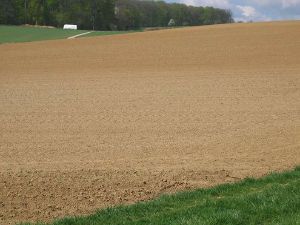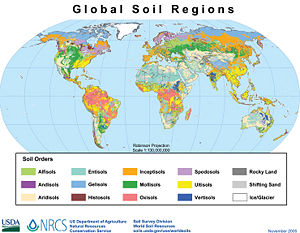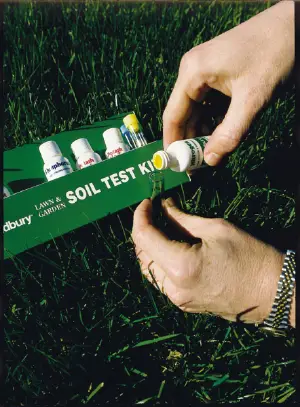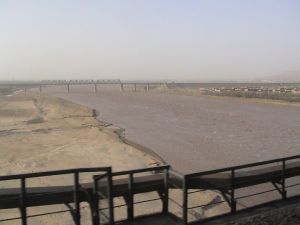Soil
Soil is the material covering most of the earth's land surface. It consists of mineral and organic matter, including living organisms. Soil is vitally important to all life on land. It is the medium of growth for almost all land plants, it provides a habitat and shelter to many animals, and it is the home to bacteria, fungi, and other micro-organisms which recycle organic material for reuse by plants.
Soil is among our most important natural resources because of its position in the landscape and its dynamic, physical, chemical, and biologic functions. While the general concept of soil is well established, the definition of soil varies, according to the perspective of the discipline or occupation using soil as a resource.
The understanding of soil is incomplete. Despite the duration of humanity's dependence on and curiosity about soil, exploring the diversity and dynamic of this resource continues to yield fresh discoveries and insights. New avenues of soil research are compelled by our need to understand soil in the context of climate change, greenhouse gases, and carbon sequestration. Our interest in maintaining the planet's biodiversity and in exploring past cultures has also stimulated renewed interest in achieving a more refined understanding of soil.
The earth's soil in general is sometimes refered to as the pedosphere and the scientific study of soil is called pedology or edaphology. Pedology is the study of soil in its natural setting. Edaphology is the study of soil in relation to soil-dependent uses.
Soil components
Mineral material
The majority of material in most soil is mineral. This consists of small grains broken off from the underlying rock or sometimes transported in from other areas by the action of water and wind. Larger mineral particles are called sand, smaller ones called silt, and still smaller ones called clay. The mineral part of soil slowly releases nutrients which are needed by plants, such as potassium, calcium, and magnesium. Recently formed soil, for instance that formed from lava recently released from a volcano, is richer in nutrients and so is more fertile (Adams 1986).
Organic material
As plants and animals die and decay they return organic material to the soil. Soils have different amounts of organic materials, from almost 100 percent in some forest soils to almost none in some deserts. Micro-organisms, such as bacteria, fungi, and protists feed on the organic material and in the process release nutrients which can be reused by plants. The micro-organisms themselves can form a significant part of the soil. Within the soil are also the roots of plants and animals such as earthworms.
Water and air
Soil almost always contains water and air in the spaces between the mineral and organic particles. Most soil organisms thrive best when the soil contains about equal volumes of water and air (Adams 1986).
Soil classification
The World Reference Base for Soil Resources (WRB) is the international standard soil classification system. Development was coordinated by the International Soil Reference and Information Centre (ISRIC) and sponsored by the International Union of Soil Sciences (IUSS) and the Food and Agriculture Organization (FAO) via its Land & Water Development division. It replaces the previous FAO soil classification.
The WRB borrows from modern soil classification concepts, including USDA soil taxonomy. The classification is based mainly on soil morphology as an expression of pedogenesis, the creation of soil. A major difference with USDA soil taxonomy is that soil climate is not part of the system, except in so far as climate influences soil profile characteristics.
Their structure is either nominal, giving unique names to soils or landscapes, or descriptive, naming soils by their characteristics such as red, hot, fat, or sandy. Soils are distinguished by obvious characteristics, such as physical appearance (e.g., color, texture, landscape position), performance (e.g., production capability, flooding), and accompanying vegetation (OS 2007). A vernacular distinction familiar to many is classifying texture as heavy or light. Light soils have lower clay content than heavy soils. They often drain better and dry out sooner, giving them a lighter color. Lighter soils, with their lower moisture content and better structure, take less effort to turn and cultivate. Contrary to popular belief light soils do not weigh less than heavy soils on an air dry basis nor do they have more porosity.
Soil characteristics
Soils tend to develop an individualistic pattern of horizontal zonation under the influence of site specific soil-forming factors. The composition of these individual soil horizons, and their relationship with the soil profile is key to understanding behavior. Soil color, soil structure, and soil texture are especially important components of soil morphology.
Soil color is the first impression one has when viewing soil. Striking colors and contrasting patterns are especially memorable. The Red River of the United States carries sediment eroded from extensive reddish soils like Port Silt Loam in Oklahoma. The Yellow River in China carries yellow sediment from eroding loessal soils. Mollisols in the Great Plains are darkened and enriched by organic matter. Podsols in boreal forests have highly contrasting layers due to acidity and leaching.
Soil color is primarily influenced by soil mineralogy. The extensive and various iron minerals in soil are responsible for an array of soil pigmentation. Color development and distribution of color within a soil profile result from chemical weathering, especially redox reactions. As the primary minerals in soil-parent material weather, the elements combine into new and colorful compounds. Iron forms secondary minerals with a yellow or red color; organic matter decomposes into black and brown compounds; and manganese forms black mineral deposits. These pigments give soil its various colors and patterns and are further affected by environmental factors. Aerobic conditions produce uniform or gradual color changes while reducing environments result in disrupted color flow with complex, mottled patterns and points of color concentration.
Soil structure is the arrangement of soil particles into aggregates. These may have various shapes, sizes and degrees of development or expression. Soil structure influences aeration, water movement, erosion resistance, and root penetration. Observing structure gives clues to texture, chemical and mineralogical conditions, organic content, biological activity, and past use, or abuse.
Surface soil structure is the primary component of tilth. Where soil mineral particles are both separated and bridged by organic-matter-breakdown products and soil-biota exudates, it makes the soil easy to work. Cultivation, earthworms, frost action and rodents mix the soil. This activity decreases the size of the peds to form a granular (or crumb) structure. This structure allows for good porosity and easy movement of air and water. The combination of ease in tillage, good moisture and air-handling capabilities, good structure for planting and germination are definitive of good tilth.
Soil texture refers to sand, silt and clay composition in combination with gravel and larger-material content. Sand and silt are the product of physical weathering while clay is the product of chemical weathering. Clay content is particularly influential on soil behavior due to a high retention capacity for nutrients and water. Due to superior aggregation, clay soils resist wind and water erosion better than silty and sandy soils. In medium-textured soils, clay can tend to move downward through the soil profile to accumulate as illuvium in the subsoil. The lighter-textured, surface soils are more responsive to management inputs, but also more vulnerable to erosion and contamination.
Texture influences many physical aspects of soil behavior. Available water capacity increases with silt and, more importantly, clay content. Nutrient-retention capacity tends to follow the same relationship. Plant growth, and many uses which rely on soil, tends to favor medium-textured soils, such as loam and sandy loam. A balance in air and water-handling characteristics within medium-textured soils are largely responsible for this.
Soil and its environment
Soil and plants
Soil is necessary for almost all land plants to survive and grow. A sprouting seed sends roots into the soil which absorb water and dissolved minerals which the new plant needs for its growth. As the plant grows its root system expands though the soil and serves to support it. The soil stores water from rain and snow allowing plants to have a continuous supply and helping to prevent destructive flooding. As plants lose their leaves and when they die organic material is returned to the soil which builds up and enriches the soil. In many environments plants also protect the soil from erosion by holding it in place with their roots and sheltering it from the effects of wind and rain.
Soil and animals
Soil and humans
Soil in nature
Soil formation processes never stop and soil is always changing. The long periods over which change occurs and the multiple influences of change mean that simple soils are rare. While soil can achieve relative stability in properties for extended periods of time, the soil life cycle ultimately ends in soil conditions that leave it vulnerable to erosion. Little of the soil continuum of the earth is older than Tertiary and most no older than Pleistocene (Hole and McCracken 1973). Despite the inevitability of soils retrogression and degradation, most soil cycles are long and productive. How the soil "life" cycle proceeds is influenced by at least five classic soil forming factors: regional climate, biotic potential, topography, parent material and the passage of time.
An example of soil development from bare rock occurs on recent lava flows in warm regions under heavy and very frequent rainfall. In such climates plants become established very quickly on basaltic lava, even though there is very little organic material. The plants are supported by the porous rock becoming filled with nutrient bearing water, for example carrying dissolved bird droppings or guano. The developing plant roots themselves gradually breaks up the porous lava and organic matter soon accumulates but, even before it does, the predominantly porous broken lava in which the plant roots grow can be considered a soil.
Most of our knowledge of soil in nature comes from soil survey efforts. Soil survey, or soil mapping, is the process of determining the soil types or other properties of the soil cover over a landscape, and mapping them for others to understand and use. It relies heavily on distinguishing the individual influences of the five classic soil forming factors. This effort draws upon geomorphology, physical geography, and analysis of vegetation and land-use patterns. Primary data for the soil survey are acquired by field sampling and supported by remote sensing.
Geologists have a particular interest in the patterns of soil on the surface of the earth. Soil texture, color and chemistry often reflect the underlying geologic parent material and soil types often change at geologic unit boundaries. Geologists classify surface soils using the 1938 USDA soil taxonomy [1] but use the current version of USDA soil taxonomy to classify the buried soils that make up the paleopedological record. Buried paleosols mark previous land surfaces and record climatic conditions from previous eras. Geologists use this paleopedological record to understand the ecological relationships in past ecosystems. According to the theory of biorhexistasy, prolonged conditions conducive to forming deep, weathered soils result in increasing ocean salinity and the formation of limestone.
Geologists and pedologists use soil profile features to establish the duration of surface stability in the context of geologic faults or slope stability. An offset subsoil horizon indicates rupture during soil formation and the degree of subsequent subsoil formation is relied upon to establish time since rupture.
Soil examined in shovel test pits is used by archaeologists for relative dating based on stratigraphy (as opposed to absolute dating). What is considered most typical is to use soil profile features to determine the maximum reasonable pit depth than needs to be examined for archaeological evidence in the interest of cultural resources management.
Soils altered or formed by man (anthropic and anthropogenic soils) are also of interest to archaeologists. An example is Terra preta do Indio, found in the Amazon river basin (Marris 2006) .
Soil uses
Gardening and landscaping provide common and popular experience with soils. Homeowners and farmers alike test soils to determine how they can be maintained and improved. Plant nutrients such as nitrogen, phosphorus, and potassium are tested for. If specific soil is deficient in these substances, fertilizers may provide them. Extensive academic reseach is performed in an effort to expand the understanding of agricultural soil science.
Earth sheltering is the architectural practice of using soil for external thermal mass against building walls. The principle is that earthen material undergoes slow temperature changes and thus presents a fairly constant surface temperature at the wall. In higher latitudes with low average annual air temperature, the potential for heat leaching requires floor and base wall insulation. Earth-based, wall-construction materials include adobe, chirpici, cob, mudbrick, rammed earth, and sod.
Organic soils, especially peat, serve as a significant fuel resource. Peat deposits are found in many places around the world. The majority of peatlands are found in high latitudes; approximately 60 percent of the world's wetlands are peat. Peatlands cover around 3 percent of the global land mass or 3,850,000 to 4,100,000 km² (). Peat is available in considerable quantities in Scandinavia: some estimates put the amount of peat in Finland alone to be twice the size of North Sea oil reserves. Peat is used to produce both heat and electricity, often mixed with wood. Peat accounts for 6.2 percent of Finland's yearly energy production, second only to Ireland. Peat is arguably a slowly renewable biofuel but is more commonly classified as a fossil fuel.
Waste management often has a soil component. Using compost and vermicompost are popular methods for diverting household waste to build soil fertility and tilth. The technique for creating Terra prêta do índio in the Amazon basin increasingly appears to have started from knowledge of soil first gained at a household level of waste management. Industrial waste management similarly relies on soil improvement to utilise waste treatment products. Compost and anaerobic digestate (also termed biosolids) are used to benefit the soils of land remediation projects, forestry, agriculture, and for landfill cover. These products increase soil organic content, provide nutrients, enhance microbial activity, improve soil ability to retain moisture, and have the potential to perform a role in carbon sequestration.
Compost and digestate are the finished products of treatment. Soil performs a more direct treatment role when it comes to septage effluent and in land application of industrial waste water.
Septic drain fields treat septic tank effluent using aerobic soil processes to degrade putrescible components. Pathogenic organisms vulnerable to predation in an aerobic soil environment are eliminated. Clay particles act like electrostatic filters to detain virus in the soil adding a further layer of protection. Soil is also relied on for chemically binding and retaining phosphorus. Where soil limitations preclude the use of a septic drain field, the soil treatment component is replaced by some combination of mechanical aeration, chemical oxidation, ultraviolet light disinfection, replaceable phosphorus retention media and/or filtration.
For industrial wastewater treatment, land application is a preferred treatment approach when oxygen demanding (putrescible) constituents and nutrients are the treatment targets. Aerobic soil processes degrade oxygen demanding components. Plant uptake and removal through grazing or harvest perform nutrient removal. Soil processes have limited treatment capacity for treating metal and salt components of waste.
Soil and land degradation
Land degradation is a human induced or natural process which impairs the capacity of land to function. Soils are the critical component in land degradation when it involves acidification, contamination, desertification, erosion, or salination.
While soil acidification of alkaline soils is beneficial, it degrades land when soil acidity lowers crop productivity and increases soil vulnerability to contamination and erosion. Soils are often initially acid because their parent materials were acid and initially low in the basic cations (calcium, magnesium, potassium, and sodium). Acidification occurs when these elements are removed from the soil profile by normal rainfall or the harvesting of crops. Soil acidification is accelerated by the use of acid-forming nitrogenous fertilizers and by the effects of acid precipitation.
Soil contamination at low levels are often within soil capacity to treat and assimilate. Many waste treatment processes rely on this treatment capacity. Exceeding treatment capacity can damage soil biota and limit soil function. Derelict soils occur where industrial contamination or other development activity damages the soil to such a degree that the land cannot be used safely or productively. Remediation of derelict soil uses principles of geology, physics, chemistry, and biology to degrade, attenuate, isolate, or remove soil contaminants and to restore soil functions and values. Techniques include leaching, air sparging, chemical amendments, phytoremediation, bioremediation, and natural attenuation.
Desertification is an environmental process of ecosystem degradation in arid and semi-arid regions, or as a result of human activity. It is a common misconception that droughts cause desertification. Droughts are common in arid and semiarid lands. Well-managed lands can recover from drought when the rains return. Soil management tools include maintaining soil nutrient and organic matter levels, reduced tillage and increased cover. These help to control erosion and maintain productivity during periods when moisture is available. Continued land abuse during droughts, however, increases land degradation. Increased population and livestock pressure on marginal lands accelerates desertification.
Soil erosional loss is caused by wind, water, ice, movement in response to gravity. Although the processes may be simultaneous, erosion is distinguished from weathering. Erosion is an intrinsic natural process, but in many places it is increased by human land use. Poor land use practices include deforestation, overgrazing, and improper construction activity. Improved management can limit erosion using techniques like limiting disturbance during construction, avoiding construction during erosion prone periods, intercepting runoff, terrace-building, use of erosion suppressing cover materials and planting trees or other soil binding plants.
A serious and long-running water erosion problem is in China, on the middle reaches of the Yellow River and the upper reaches of the Yangtze River. From the Yellow River, over 1.6 billion tons of sediment flow each year into the ocean. The sediment originates primarily from water erosion in the Loess Plateau region of northwest China.
One of the main causes of soil erosion in is slash and burn treatment of tropical forests.
Soil piping is a particular form of soil erosion that occurs below the soil surface. It is associated with levee and dam failure as well as sink hole formation. Turbulent flow removes soil starting from the mouth of the seep flow and subsoil erosion advances upgradient.
Soil salination is the accumulation of free salts to such an extent that it leads to degradation of soils and vegetation. Consequences include corrosion damage, reduced plant growth, erosion due to loss of plant cover and soil structure, and water quality problems due to sedimentation. Salination occurs due to a combination of natural and human caused processes. Aridic conditions favor salt accumulation. This is especially apparent when soil parent material is saline. Irrigation of arid lands is especially problematic. All irrigation water has some level of salinity. Irrigation, especially when it involves leakage from canals, often raise the underlying water table. Rapid salination occurs when the land surface is within the capillary fringe of saline groundwater.
An example of soil salination occurred in Egypt in the 1970s after the Aswan High Dam was built. The source water was saline. The seasonal change in the level of ground water before the construction had enabled salt flushing, but lack of drainage resulted in the accumulation of salts in the groundwater. The dam supported irrigation which raised the water table. A stable, shallow water table allowed capillary transport and evaporative enrichment of salts at the soil surface, depressing crop productivity below pre-project levels.
Preventing soil salination involves flushing with higher levels of applied water in combination with tile drainage.
ReferencesISBN links support NWE through referral fees
- Adams, J.A. 1986. Dirt. College Station, Texas : Texas A&M University Press ISBN 0890963010
- Marris, E. 2006. "Black is the new green". Nature, August, 2006 [1]
- Soil Survey Staff. (1975) Soil Taxonomy: A basic system of soil classification for making and interpreting soil surveys. USDA-SCS Agric. Handb. 436. U.S. Gov. Print. Office. Washington, DC.
- Soil Survey Division Staff. (1993) Soil survey manual. Soil Conservation Service. U.S. Department of Agriculture Handbook 18.
- Logan, W. B., Dirt: The ecstatic skin of the earth. 1995 ISBN 1-57322-004-3
- Faulkner, William. Plowman's Folly. New York, Grosset & Dunlap. 1943. ISBN 0-933280-51-3
- Jenny, Hans, Factors of Soil Formation: A System of Quantitative Pedology 1941
- Why Study Soils?
- Soil notes
- 97 Flood. USGS. Retrieved 2006-05-31. Photographs of sand boils.
- Oregon State University's Soils (wiki)
- OpenAg.info's Soil Science Encyclopedia (wiki)
- European Soil Portal EUSOILS (wiki
Credits
New World Encyclopedia writers and editors rewrote and completed the Wikipedia article in accordance with New World Encyclopedia standards. This article abides by terms of the Creative Commons CC-by-sa 3.0 License (CC-by-sa), which may be used and disseminated with proper attribution. Credit is due under the terms of this license that can reference both the New World Encyclopedia contributors and the selfless volunteer contributors of the Wikimedia Foundation. To cite this article click here for a list of acceptable citing formats.The history of earlier contributions by wikipedians is accessible to researchers here:
The history of this article since it was imported to New World Encyclopedia:
Note: Some restrictions may apply to use of individual images which are separately licensed.
- ↑ Brevik, Eric C. (November 2002). Soil Classification in Geology Textbooks. Journal of Geoscience Education 50 (5): 539-543.






